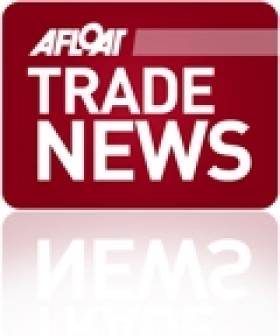Displaying items by tag: Bavaria
Yacht Capsizes in Surf at Spanish Port of Zumaia
#capsize – A Bavaria 38 yacht, with seven crew on board, enters the narrow channel leading to the port of Zumaia on the Basque coast of Spain this month with dramatic consequences. 'The swell is of medium size, the operation is dangerous, but passable' according to local photographer Gabi Aymat who shot this dramatic capsize video.
A huge wave sweeps on to the boat and rolls it over knocking some of its untethered crew over board. The good news is that the crew survived and the boat is also safe, surviving its roll without any serious damage, according to Aymat.
Bavaria 33 HT Motor Cruiser With Big Price Reduction
With a normal retail price well in excess of €250,000 O'Sullivan's marine of Tralee have just added a Bavaria 33 HT Sports Cruiser to the Afloat Boats for Sale site with a final price reduction on this Demo model. 'Going, going for - €125,0000 ex Vat' says the Kerry Yacht Broker. Check out the full listing on the boat here.
We want your boat!
Selling your sailing cruiser, motor boat, dinghy, speedboat or even your kayak?
Our Boats for Sale website has been updated. We've listened to the needs of you, the buyers and sellers to bring you the site Ireland needs for boat trading.
Firstly, our aim is to generate Ireland's largest stock of quality boats for sale, in order to do this we've introduced a modest charge of €10 to list your boat for 60 days. We've simplified the steps involved to advertise your boat, and once you've walked through them here are some of the advantages your boat has to gain maximum exposure...
Your boat will be added to Ireland's largest boating mailing list with over 10,000 subscribers, giving your boat more exposure both at home and abroad
- Your boat will be part of Ireland's largest marine portal site, having 3,000+ visitors per day
- Upload images, video, pdf spec list and google maps, helping overseas buyers establish transport arrangements etc
- Latest boats appear through a feed on every page of afloat.ie, there are 15000+ pages
- Facebook integration helps people 'share' your boat with more targeted buyers
- Your boat will be listed and tweeted to our 1,200 twitter followers and 2,200 Facebook fans
- Listing in Afloat magazine, Ireland's Boating and Sailing Magazine
Autumn Boat Shows Remain Upbeat About Next Season
As dark clouds continue to overshadow events as home there is some comfort to read about green shoots elsewhere in Europe, especially marine industry green shoots. In Germany, at least the boating industry is highly optimistic about its sales for the coming season, as witnessed by the lavish new boats to be on display from September 18 to 26, 2010 at the INTERBOOT exhibition. And there's more good news from the UK where the Southampton boat Show kicks off on Friday.
Here's the upbeat 'Press Releases' received at afloat.ie, we're glad to get them!
Friedrichshafen, Germany - The boating industry is highly optimistic about its sales for the coming season, as witnessed by the lavish new boats on display from September 18 to 26, 2010 at INTERBOOT. The new motor boats primarily offer speed and fun and the latest sailing yachts continue to emphasize sporting performance, without sacrificing comfort for the crew below deck.
A typical representative of the "speed and fun" segment is the new 7.56-meter Key Largo 27 from the Italian shipbuilder Sessa, with two 150 hp outboard motors providing a top speed of 41 knots or over 75 km/h. At anchor the boat quickly turns into a private island thanks to the sundeck in front of the cockpit's windscreen. A cozy berth offers sleeping space for two.
With four berths in two cabins and a lounge, pantry and bathroom, the new 10.8-meter Bavaria Sport 34 offers considerably more comfort below deck. Two gasoline motors (on the standard model) deliver a total of 450 hp to guarantee exhilarating speeds. For boating enthusiasts who prefer better fuel economy and lower top speeds, Germany's largest yacht builder also offers this sport boat in a diesel version with two 220 hp motors. One of the most striking motorized boats on display at INTERBOOT is the 8.3-meter Swiss-Cat 27 Geta from Swiss shipbuilder Aarewerft Lehmann. This world debut is a space-saving miracle, with up to 5 berths below deck and room on deck for up to 12 passengers to enjoy the speed of this fast-planing yacht powered by a 300 hp motor.
Another attention-grabber will be the new 6.1-meter rigid inflatable from Ott Wassersport e.K. in Meersburg as it skims over Lake Constance at breathtaking speeds, propelled by a lightweight jet-propulsion motor. This boat features an impressive functional design, including a sheltered helm position.
Another world premiere, the Linssen Grand Sturdy Hybrid from the Netherlands, will be the focus of attention for skippers who want to avoid CO2 emissions as they quietly and leisurely explore lakes and rivers in this 8.2-meter steel yacht. It has an especially hydrodynamic hull and an electric motor powered by state-of-the-art batteries, which can be charged by a 3-kilowatt generator or mains electricity from a mooring connection. And the spaciousness of this Linssen model is just as remarkable as its propulsion system: A large master cabin and a lounge can both be found below deck.
Sailing yacht manufacturers are also taking advantage of the INTERBOOT as an opportunity to debut their boats for the coming watersports season. The two largest German companies in this sector, Bavaria Yachtbau GmbH and the Hanse Group, have a spectacular array of INTERBOOT premieres, and new boats are also on display from other shipbuilders such as Hunter from the USA and Jeanneau from France.
Jeanneau has finished production of its new 12.34-meter Sun Odyssey 409 just in time for INTERBOOT, allowing it to showcase the craft as a global debut. With a displacement of 7.5 tons, this fast cruiser carries the hallmark of its designer Philippe Briand and is suited to both coastal cruises and the open sea. The 409 reflects the latest advances in yacht design. It is available with either two or three double cabins, twin helms, and has a bow that angles almost straight down to the waterline. The close-hauled sail area of nearly 80 square meters ensures a high average sailing speed.
Modern hulls and plenty of space below deck are also included in two new boats from the Bavaria Yachts - the Cruiser 36 and Cruiser 40 (11.3 and 12.35 meters, respectively). Like all new Bavaria yachts, the design is by Bruce Farr and the interior was created by BMW Group Designworks USA. Bavaria is also now sporting a new signature style to accompany its yachts' improved sailing performance.
The Hanse 325 from the Greifswald-based Hanse Group is a somewhat smaller boat (9.55 meters). This yacht's designation as a fast 'performance cruiser' belies the fact that it provides a generous amount of living space and comfort below deck.
The Greifswalders took over the Dehler shipyard and are now presenting the new Dehler 32 - a 9.8-meter cruiser racer which has already tasted regatta success. The 32-footer with its displacement of around four tons moves at a good clip thanks to 60 square meters of sail area. The yacht was designed by Judel/Vrolijk & Co. – the engineering geniuses who have already helped propel the Swiss Americas Cup syndicate "Alinghi" to two Cup victories. Sailing gets even sportier with the Dinamica RS 940 hi-tech day sailer from Italy, which is enjoying its world premiere here. The 9.4-meter racer designed by the regatta yacht specialist Claudio Maletto has a displacement of merely 2.1 tons, allowing it to fly across the water with a huge sail area of 58 square meters.
One of the largest sailing yachts at INTERBOOT is the new 15.21-meter Hunter 55 CC from the USA. Sailing is pure luxury on this ocean-going yacht, as illustrated by a whirlpool cleverly concealed under the master suite's double bed. A small crew is sufficient to handle the yacht as it sails the seas at impressive speeds with 114 square meters of sail area.
INTERBOOT is also traditionally an opportunity for the boating accessories industry to showcase its innovations for the first time. These include the latest electronic navigation products and current developments in sailing technology, such as remarkably light high-tension sheets and halyards, advanced roller furling systems and technical sailing clothing for all weathers. Additionally, owners of smaller yachts and boats can look forward to the new generation of multi-purpose handsets, such as VHF radios with built-in GPS devices, and navigation lights and interior lighting with energy-efficient LEDs.
More information is available at www.interboot.de.
Southampton, England - Make the most of the last days of summer at the PSP Southampton Boat Show. From 10 – 19 September 2010, the UK's leading outdoor boat show returns to Mayflower Park, bringing hundreds of boats, exhibitors and visitors together on the south coast.
Set on one of Europe's largest marinas, the PSP Southampton Boat Show in association with ITV Meridian offers an essential interactive experience for everyone with an interest in boats, on-water adventures and an active lifestyle, from sailing enthusiasts through to families and the 'just curious.'
Over 10 action-packed days, visitors to this year's PSP Southampton Boat Show can enjoy the very best of the UK's vibrant marine industry:
Keep updated on Show news and developments and book tickets from early June via the PSP Southampton Boat Show website – http://www.southamptonboatshow.com/, or call the ticket hotline on 0871 230 7140.






























































